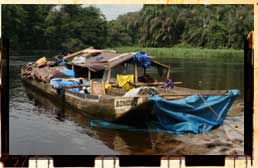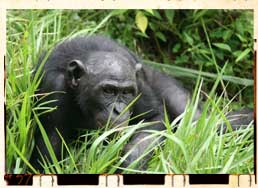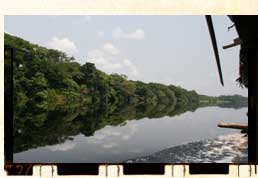Congo and Bonobo Expedition Article
Angus Gemmell
"Congo". The very word, spoken as if with a drumbeat at the back of the tongue, conjures foreboding. A vast jungle, an impenetrable wilderness, where the only avenues of open space and light are the web of waterways that drain a basin the size of western Europe. This is the land vividly engrossed into the world's imagination by Joseph Conrad as the "Heart of Darkness". True it is that over the last century and a half no where else on the planet has seen more unceasing human suffering.
On top of the rapacious brutalities inflicted by the Belgian colonialists, promptly followed by the tyrannies of President Mobutu's reign, the Democratic Republic of Congo was ravaged between 1996 to 2002 by what was dubbed Africa's World War. It's one of modern times' most neglected facts that an estimated 4 million Congolese perished in those years as a result of the war waged by six African nations.
How striking then that amid what seems a black hole of tragedy there lives one of the most peaceful, gregarious, intelligent and cohesive of species. That this species, the bonobo, also happens to be the closest living relative to humanity, makes their existence in this great dark realm of human agony all the more of an improbable oasis of light.
Surprised? You may be excused for never having heard of the bonobo. Their habitat is so remote, and the Congo so savaged by successive wars, that only a few of the hardiest scientists have had the tenacity to study them at length and attempt to bring them to the world's attention. Barely a handful of film crews have ever recorded their startling behaviour in the wild.
That bonobos frequently walk bipedally -- they stand four and a half feet tall -- use an endless variety of sexual pleasure as a way of avoiding conflict, have the intelligence and language capacity of a 3yr old human child, are largely matriarchal and display a capacity for nurturing that would be the envy of any mother, should be enough to make us take notice. Along with the chimpanzee they share 98.6% of the same DNA as humanity. They provide a vastly different model however for human heritage than the more volatile and violent chimpanzee. Scientists speculate that perhaps it was from a time such as bonobos now enjoy that we acquired our sense of morality as well as capacities for love and idealism. It's high time we paid our closest and most endangered cousin the respect they deserve, lest they, and the lessons they can teach us about our own origins, disappear altogether. The bonobo identity crisis has persisted far too long.
I owe my interest in bonobos to having some 16 years ago come across the explanations of an Australian biologist, Jeremy Griffith, on the human condition. Since then, and having had a stint in Washington DC working for the Bonobo Conservation Initiative (BCI) in 2001, I have harboured a longing to spend time with bonobos in the wild, and to observe and film their remarkable behaviour. At last, in the current window of peace in the Congo, the opportunity to embark on a 1,500km expedition up river has arisen, and with it with the hope of reaching the BCI's research and conservation centre in a region known as Kokolopori.
On board are two Australian friends, Dr Luke Bennett and Phil Strickland SC, as well as the American Executive Director of BCI, Michael Hurley. The native Congolese contingent consists of the BCI's extremely capable director in the Congo, Bianco, as well as the BCI's trusty river guide, Le Blanc -- "the white" -- so named for his piercing green eyes set in an African face. His eyes would frequently aflame an even greater colour when fuming with his pet disdain for the vagaries of the many bureaucrats we encounter along the way, each wanting their own wedge of cash for our "safe passage".
Next page









